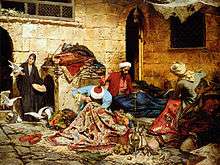Rudolf Swoboda
Rudolf Swoboda (4 October 1859 – 24 January 1914), sometimes given the epithet of The Younger, was a 19th-century Austrian painter, born in Vienna.
Rudolf Swoboda | |
|---|---|
| Born | 4 October 1859 Austria |
| Died | 24 January 1914 Austria |
| Nationality | Austrian |
| Education | Leopold Carl Müller |
| Known for | Painter |
| Movement | Orientalist |
Biography


He studied under his uncle Leopold Carl Müller, and voyaged with him to Egypt in 1880. He was a well-known Orientalist. His sister was the portrait painter Josefine Swoboda, also well-known for her portraits of the British royal family.
In 1886, Queen Victoria commissioned Swoboda to paint several of a group of Indian artisans who had been brought to Windsor as part of the Golden Jubilee preparations. Victoria liked the resulting paintings so much that she paid Swoboda's way to India to paint more of her Indian subjects.[1]
Swoboda painted many of the ordinary people of India in a grouping of small (no more than eight inches high) paintings which resulted.
While in India, he stayed, part of the time, with John Lockwood Kipling, and met his son Rudyard Kipling. The younger Kipling was unimpressed with Swoboda, writing to a friend about two "Austrian maniacs" who thought they were "almighty" artists aiming to "embrace the whole blazing East".[2]
Upon his return from India, he also painted (in 1888 and 1889) two portraits of Abdul Karim (the Munshi), Victoria's favourite Indian servant.
Most of these Indian paintings hang at Osborne House, once Victoria's residence on the Isle of Wight.[3]
The record price paid for a Swoboda painting was for The Carpet Menders, which sold in 2008 for 2.6 million USD at Christies.
References
- The Times – Interact with us at www.suntimes.co.za
- ArtsEtc: `I want to see my subjects as they really are' | Independent on Sunday, The | Find Articles at BNET at www.findarticles.com
- Product not found at www.nationalgallery.co.uk
See also
External links
![]()